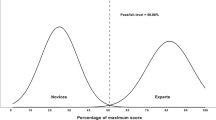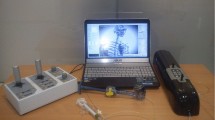Abstract
Purpose
Training in Interventional Radiology currently uses the apprenticeship model, where clinical and technical skills of invasive procedures are learnt during practice in patients. This apprenticeship training method is increasingly limited by regulatory restrictions on working hours, concerns over patient risk through trainees’ inexperience and the variable exposure to case mix and emergencies during training. To address this, we have developed a computer-based simulation of visceral needle puncture procedures.
Methods
A real-time framework has been built that includes: segmentation, physically based modelling, haptics rendering, pseudo-ultrasound generation and the concept of a physical mannequin. It is the result of a close collaboration between different universities, involving computer scientists, clinicians, clinical engineers and occupational psychologists.
Results
The technical implementation of the framework is a robust and real-time simulation environment combining a physical platform and an immersive computerized virtual environment. The face, content and construct validation have been previously assessed, showing the reliability and effectiveness of this framework, as well as its potential for teaching visceral needle puncture.
Conclusion
A simulator for ultrasound-guided liver biopsy has been developed. It includes functionalities and metrics extracted from cognitive task analysis. This framework can be useful during training, particularly given the known difficulties in gaining significant practice of core skills in patients.








Similar content being viewed by others
Notes
http://www.craive.org.uk (last accessed 16 Apr 2013).
http://www.itksnap.org/ (last accessed 06 Jan 2013).
Safety fistula needle manufactured by Kimal, http://www.kimal.co.uk/ (last accessed 16 Apr 2013).
Hollow needle used in IR, named after Chiba University in Japan, where it was invented.
http://www.h3dapi.org/ (last accessed 16 Apr 2013).
http://www.sensegraphics.com/ (last accessed Apr 16, 2013).
References
Bauer C, Aurich V, Arzhaeva EA (2009) Comparison and evaluation of methods for liver segmentation from CT datasets. IEEE Trans Med Imag 28(8):1251–1265
Bottger T, Kunert T, Meinzer HP, Wolf I (2007) Application of a new segmentation tool based on interactive simplex meshes to cardiac images and pulmonary MRI data. Acad Radiol 14(3):319–329
Chi Y, Cashman PMM, Bello F, Kitney RI (2007) A discussion on the evaluation of a new automatic liver volume segmentation method for specified CT image datasets. In: van Ginneken B, Heimann T, Styner M (eds) workshop on 3D segmentation in the clinic: a grand challenge. Med Image Comput Comput Assist Interv. MICCAI, pp 167–175
Coles TR, John NW, Gould DA, Caldwell DG (2011) Integrating haptics with augmented reality in a femoral palpation and needle insertion training simulation. IEEE Trans Haptics 4(3): 199–209
Delorme S, Laroche D, DiRaddo R, Del Maestro RF (2012) Neurotouch: a physics-based virtual simulator for cranial microneurosurgery training. Neurosurgery 71(1 Suppl Operative):32–42. doi:10.1227/NEU.0b013e318249c744
Dillenseger JL, Laguitton S, Delabrousse E (2009) Fast simulation of ultrasound images from a CT volume. Comput Biol Med 39(2):180–186
Forest C, Comas O, Vaysière C, Soler L, Marescaux J (2007) Ultrasound and needle insertion simulators built on real patient-based data. Stud Health Technol Inform 125:136–139
Forest C, Comas O, Vaysière C, Soler L, Marescaux J (2007) Ultrasound and needle insertion simulators built on real patient-based data. In: Proceedings of MMVR 15, pp 136–139
Fornage B (1989) A simple phantom for training in ultrasound-guided needle biopsy using the freehand technique. J Ultrasound Med 8:701–703
Gibson SF (1997) 3D chainmail: a fast algorithm for deforming volumetric objects. In: Proceedings of the symppsium on interactive 3D graphics. ACM, New York, pp 149–154. ISBN 0-89791-884-3. http://doi.acm.org/10.1145/253284.253324
Hoppe H, DeRose T, Duchamp T, Mcdonald J, Stuetzle W (1992) Surface reconstruction from unorganized points. In: Computer graphics (SIGGRAPH ’92 proceedings), pp 71–78
Ibanez L, Schroeder W, Ng L, Cates J (2005) The ITK software guide, 2nd edn. Kitware. ISBN 1-930934-15-7. http://www.itk.org/ItkSoftwareGuide.pdf
Johnson S, Hunt C, Woolnough H, Crawshaw M, Kilkenny C, Gould D, Sinha A, England A, Villard PF (2011) Virtual reality, ultrasound-guided liver biopsy simulator: development and performance discrimination. Br J Radiol. doi:10.1259/bjr/47436030
Karuppasamy K, Zhai J, How T, Gould D (2008) Development and validation of an unobtrusive sensor for in-vivo force data collection during interventional procedures. Cardiovasc Interv Radiol 32: 22–23
Li Y, Brodlie K (2003) Soft object modelling with generalised chainmail—extending the boundaries of web-based graphics. Comput Graph Forum 22(4):717–728
Lorensen WE, Cline HE (1987) Marching cubes: a high resolution 3D surface construction algorithm. Siggraph Comput Graph 21(4):163–169. doi:10.1145/37401.37422
Lovquist E, O’Sullivan O, Oh’Ainle D, Baitson G, Shorten G, Avis N (2011) Vr-based training and assessment in ultrasound-guided regional anesthesia: from error analysis to system design. In: MMVR, vol 163. IOS Press, pp 304–310
Magee D, Zhu Y, Ratnalingam R, Gardner P, Kessel D (2007) An augmented reality simulator for ultrasound guided needle placement training. J Med Biol Eng Comput 45:957–967
Maurin B, Barbé L, Bayle B, Zanne P, Gangloff J, de Mathelin M, Soler L, Forgione A (2004) In vivo study of forces during needle insertions. In: Proceedings of the medical robotics, navigation and visualisation scientific workshop 2004. Germany, Remagen
McNamara MP Jr, McNamara ME (1989) Preparation of a homemade ultrasound biopsy phantom. J Clin Ultrasound 17(6):456–458
Meier U, López O, Monserrat C, Juan MC, Alcañiz M (2005) Real-time deformable models for surgery simulation: a survey. Comput Methods Prog Biomed 77(3):183–197
Parikh SS, Chan S, Agrawal SK, Hwang PH, Salisbury CM, Rafii BY, Varma G, Salisbury KJ, Blevins NH (2009) Integration of patient-specific paranasal sinus computed tomographic data into a virtual surgical environment. Am J Rhinol Allergy 23(4):442–7. doi:10.2500/ajra.2009.23.3335
Shams R, Hartley R, Navab N (2008) Real-time simulation of medical ultrasound from CT images. LNCS 5242:734–741
Stern J, Zeltser IS, Pearle MS (2007) Percutaneous renal access simulators. J Endourol 21(3):270–3
Tabriz DM, Street M, Pilgram TK, Duncan JR (2011) Objective assessment of operator performance during ultrasound-guided procedures. Int J Comput Assist Radiol Surg 6(5):641–652
van Gerwen DJ, Dankelman J, van den Dobbelsteen JJ (2012) Needle-tissue interaction forces—a survey of experimental data. Med Eng Phys
Vidal FP, John NW, Gould DA, Healey AE (2008) Simulation of ultrasound guided needle puncture using patient specific data with 3D textures and volume haptics. Comput Anim Virtual Worlds 19(2):111–127. doi:10.1002/cav.217
Vidal FP, Villard P, Lutton E (2012) Tuning of patient specific deformable models using an adaptive evolutionary optimization strategy. IEEE Trans Biomed Eng 59(10):2942–2949. doi:10.1109/TBME.2012.2213251
Villard PF, Boshier P, Bello F, Gould D (2011) Virtual reality simulation of liver biopsy with a respiratory component. In: Takahashi H (ed) Liver biopsy. InTech. http://hal.inria.fr/inria-00621263
Villard PF, Vidal FP, Hunt C, Bello F, John NW, Johnson S, Gould DA (2009) A prototype percutaneous transhepatic cholangiography training simulator with real-time breathing motion. Int J Comput Assist Radiol Surg 4(6):571–578. doi:10.1007/s11548-009-0367-1
Wahba G (1990) Spline models for observational data, vol 59. Society for Industrial and, Applied Mathematics, Philaedelphia
Willaert WIM, Aggarwal R, Van Herzeele I, Cheshire NJ, Vermassen FE (2012) Recent advancements in medical simulation: patient-specific virtual reality simulation. World J Surg 36(7):1703–1712. doi:10.1007/s00268-012-1489-0
Willaert WIM, Aggarwal R, Van Herzeele I, Plessers M, Stroobant N, Nestel D, Cheshire N, Vermassen F (2012) Role of patient-specific virtual reality rehearsal in carotid artery stenting. Br J Surg 99(9):1304–13. doi:10.1002/bjs.8858
Wilson TA, Legrand A, Gevenois PA, De Troyer A (2001) Respiratory effects of the external and internal intercostal muscles in humans. J Physiol 530(2):319–330
Yushkevich PA, Piven J, Cody Hazlett H, Gimpel Smith R, Ho S, Gee JC, Gerig G (2006) User-guided 3D active contour segmentation of anatomical structures: significantly improved efficiency and reliability. Neuroimage 31(3):1116–1128
Acknowledgments
We would like to thank the late Roger Phillips for his significant contributions to the project. We acknowledge funding from the UK’s Department of Health through the Health Technology Devices programme.
Conflict of Interest
P. F. Villard, F. P. Vidal, L. ap Cenydd, R. Holbrey, S. Pisharody, S. Johnson, A. Bulpitt, N.W. John, F. Bello and D. Gould declare that they have no conflict of interest.
Author information
Authors and Affiliations
Corresponding author
Rights and permissions
About this article
Cite this article
Villard, P.F., Vidal, F.P., ap Cenydd, L. et al. Interventional radiology virtual simulator for liver biopsy. Int J CARS 9, 255–267 (2014). https://doi.org/10.1007/s11548-013-0929-0
Received:
Accepted:
Published:
Issue Date:
DOI: https://doi.org/10.1007/s11548-013-0929-0




